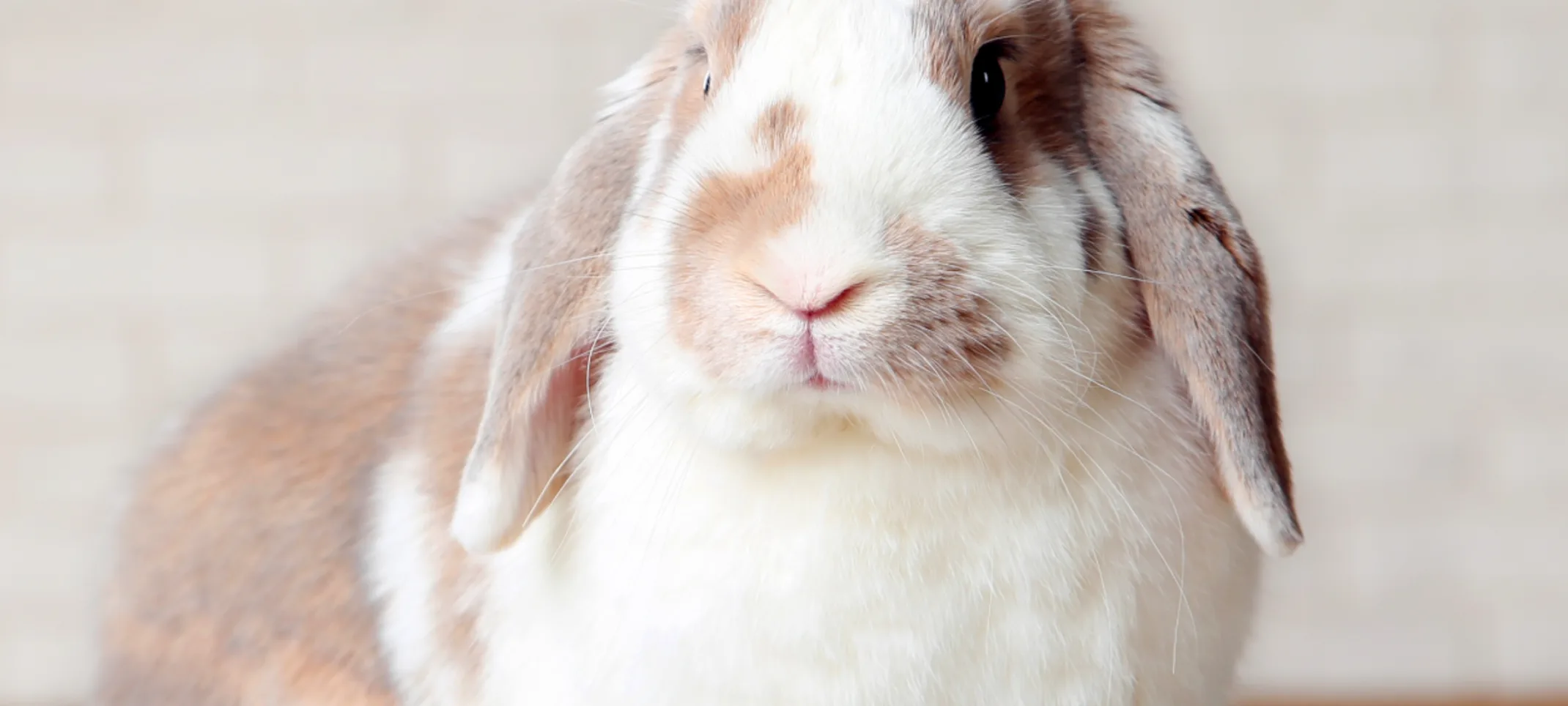I-20 Animal Medical Center
Rabbit Husbandry
Rats make excellent pets. They are friendly, clean and easy to handle once they get used to an owner.

There is nothing sweeter than fuzzy bunny kisses to warm your heart! Rabbits are faithful, sociable, clean animals that can be wonderful pets as long as they are cared for properly. These pets are as much of a commitment as a dog, as they can live up to and over 10 years of age. There are many different breeds of rabbits available, from New Zealand Whites to French Lops. Each breed has differences in size and personality, so if you do your research before you adopt, you will have a charming little companion!
Getting to Know Your Rabbit
Rabbits are naturally curious and outgoing, and most are highly sociable creatures. Handling your rabbit should not be hard once you get to know your rabbit’s preferences and personality. Make sure to NEVER pick your rabbit up by the ears. This is dangerous and can cause serious health issues. You must also make sure to support your rabbit’s hind limbs when picking him up. Rabbits can break their backs and cause paralysis if they kick too hard while being held.
When picking up your rabbit, cradle one hand under the chest or gently grab some skin on the back of the neck, and place your other hand underneath the back legs, supporting them. You can also use a towel to help “burrito” your rabbit up.
Housing
Rabbits should be kept indoors in Texas as they are prone to overheating in the hotter months of the year if kept outside. Most commercial rabbit hutches are actually way too small for rabbits to exist comfortably in their homes. Pick as large of an enclosure as possible, with 2 levels. Flooring should be solid – avoid wire mesh as this can cause foot pad lesions as well as increase the risk of getting toes caught in the wire mesh. Hide boxes are important to allow your rabbit to feel safe. Food bowls should be heavy ceramic and hard to tip over. Water bottles typically are better than bowls. Fresh food and water should be provided daily, and water bottles and food bowls should be cleaned daily. Always keep your rabbit in a hutch or cage when you are not home, or a very special bunny-proofed room.
Rabbits will chew on electrical cords, bed skirts, and other inappropriate items that can be dangerous. If you must choose a smaller-than-ideal hutch for your rabbit, treat this like you would a dog being crated during the day while you are gone – it is important for your rabbit to have lots of time outside of the cage when you get home to run off some energy! If you find you do not have the time you need to allow your rabbit out of the cage, consider a larger enclosure or hutch.
Substrate
For a soft padding on the bottom of your rabbit’s cage, provide a recycled newspaper product like Carefresh bedding, or you can use some hay as a bedding as well. Do NOT use natural beddings like pine, cedar, aspen, corncob, or wood chips or shavings as these can create high amounts of dust and cause respiratory irritation. The natural beddings can also grow bacteria and fungus despite being cleaned regularly, and can lead to pneumonia. Change the substrate every few days to avoid ammonia buildup.
Nutrition
A rabbit’s diet is a vital part of its husbandry. An inappropriate diet can lead to diseases and problems later on in life. Timothy hay should be fed free choice and be available to rabbits at all times. This not only allows them to continuously eat (which is important for their proper digestion) but the hay provides a way to keep their constantly growing teeth ground down in a normal alignment.
Rabbits should also receive a commercial pelleted diet (Oxbow and Mazuri are good brands) daily. Fresh, dark leafy greens (mustard greens, collard greens, dandelion greens, cilantro, parsley, raspberry leaves) can be fed in small amounts daily. Avoid broccoli, spinach and cabbage as these can produce gas and intestinal upset as well as increase the risk of bladder stones. Rabbits over 6 months of age should not be fed Alfalfa hay as this is too rich for them.
Medical Care
New pet rabbits should be examined within the first week to look for any signs of illness and intestinal parasites. Bring your rabbit in a carrier or travel cage for safety. Exams should then be performed once a year (twice a year in rabbits over 5) to make sure your rabbit is healthy. Preventative spaying and neutering is helpful to not only prevent certain diseases but also increase lifespan.
Knowing the common diseases in rabbits and what signs to look for will help you know if you need to bring your rabbit in for an exam. With exotic pets, they tend to hide signs of illness until they can no longer possibly maintain the appearance of being normal. This is because they are prey animals, and their instincts tell them that to survive they must look happy and healthy or they will be targeted by predators. Unfortunately for us, this means that usually when we first notice our pet rabbits are sick, they have actually been sick for days if not weeks. You usually don’t have the luxury of a “wait and see” approach to see if your rabbit is going to get better without treatment. Early medical care is vital to helping your rabbit!
Here are some common diseases in rabbits and what signs to watch for in your pets:
Dental disease/malocclusion (also called “slobbers”)
Seen in older rabbits and younger rabbits fed a diet low in hay, dental disease can be a frustrating disease to treat. Because rabbits have continuously growing teeth, if the teeth are not ground down by chewing on food and other objects like wooden toys, the teeth can overgrow. Sharp points on the teeth can cause oral pain, infections, and even grow to entrap the tongue if left untreated long enough. Signs of dental disease include slobbering or excessive drooling, decreased appetite, preference for soft foods, pawing at or rubbing at the mouth, and intestinal upset. Treatment includes addressing the current teeth overgrowth and adjusting husbandry to prevent it in the future. Treatment is usually needed for life once malocclusion happens.
Pneumonia/respiratory infections (“snuffles”)
Rabbits can get many different causes of upper and lower respiratory infections, the most common being irritation from dusts from natural beddings, Pasteurella, and other bacterial infections. Signs include discharge from the eye and nose, ear infections that can cause head tilts, increased respiratory rates, clicks or crackles when breathing, and appetite loss. Upper respiratory infections can progress to pneumonia, so early intervention is important.
Ear mites
Newly acquired rabbits can sometimes come with ear mites. It is usually not hard to miss these infections, as there is typically discharge from the ears, and the ears can become completely covered with a white plaque-like, crusty scabbing. In severe cases, this ear crusting can move and cover the areas around the eyes. This can ulcerate and is very painful and itchy. The mites can easily be seen under the microscope.
Enteritis
Rabbits on poor diets, those with sudden diet changes, and those with underlying illnesses or stress can be prone to intestinal disease. Signs include loose fecal pellets or diarrhea, decreased frequency of fecal pellets, decreased appetite, lethargy, and with worsening dehydration, sunken eyeballs and wrinkly skin. Because rabbits need to eat often to keep their beneficial intestinal bacteria healthy, intestinal inflammation causing appetite loss can be deadly if not treated early. If your rabbit has gone 12 or more hours without eating, this indicates a problem that needs veterinary attention.
Hairballs
Hairballs are a common source of intestinal upset in rabbits. Because rabbits cannot throw up, if a hairball is stuck in the stomach or intestinal tract, we typically see appetite loss, drooling, and lethargy as the main signs rather than vomiting to indicate nausea. Frequent grooming, a proper diet, and preventative medications if your rabbit is prone to hairballs can help reduce the frequency. Sometimes hairballs are so severe that surgery is needed to remove them.
E. cuniculi
This is an organism that can cause severe head tilts and neurological signs in rabbits. Treatment is symptomatic. It is important to diagnose this as a cause of your rabbit’s symptoms if you have other rabbits that can be affected since this is a contagious disease.
A minimum of a 30 day quarantine period is recommended for any new pet being brought into a home with existing exotic pets. This is to protect the owner’s previous pets from any new diseases or parasites a new pet could be carrying. Most infectious diseases will have symptoms show up within that 30 day period. Quarantined pets should be kept in a separate room if possible, and have separate food and water bowls throughout the quarantine period. Handle your previous pets first, then handle your new pet last. After the quarantine period is over, and your new pet has shown no signs of illness and has seen a veterinarian, your previous pets should be safe from most communicable diseases.
